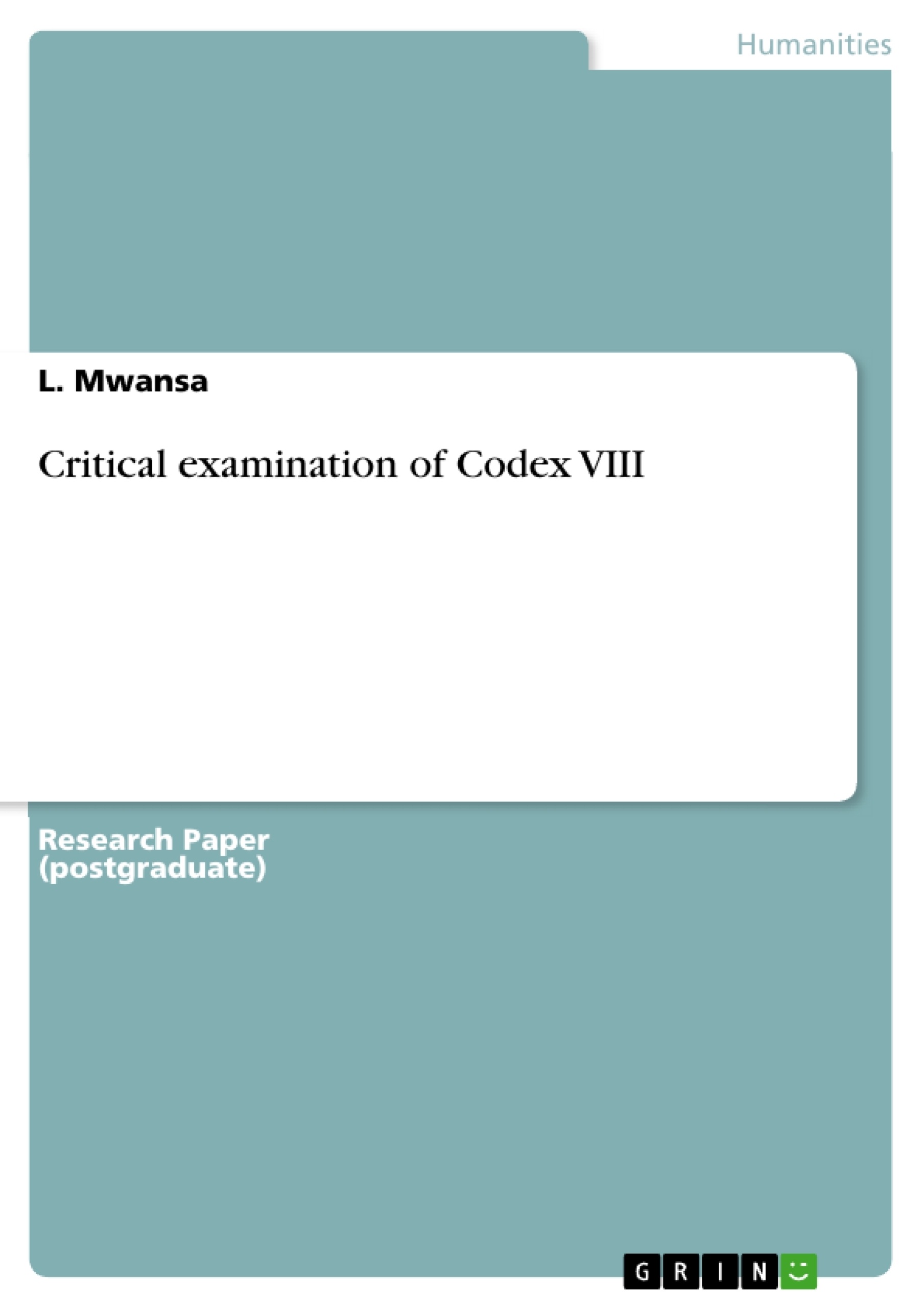This paper deals with the critical examination of Codex VIII.
According to James Robinson in his book The Coptic Gnostic Library he writes, Nag Hammadi Codex VIII (CG VIII, NHC VIII), the manuscript was formerly numbered Codex VII by Doresse Mina, IX by Puech, and IV by Doresse, Les Livres secrets as can be seen from Robinson, Facsimile Edition: Codex VIII, pp. vii and ix. Papyrus codex were very imperfect with original folios of 242 mm high and 147 mm wide. Before conservation many leaves or leaf fragments of the codex were in several pieces which have now been restored. Before 1961, the text block was attached to its ancient binding, or in loose fragments but later completely disbound, and the quire sheets cut apart into leaves in 1961, however, they were rejoined between 1970 and 1976, and are conserved in plexiglas frames, with the ancient codex page numbers.
The ancient binding is kept separately (inv. 10550). One hundred twenty-six fragments of cartonnage have been taken away from the binding and are also preserved separately (Facsimile Edition: Cartonnage, 59 to 70; Barns Browne Shelton, Nag Hammadi Codices: Cartonnage, 87 to 102, transcribing 43 fragments; 83 other fragments were too small to be transcribed). In original form, the text block (in a single quire) consisted of 74 leaves of which two were flyleaves, two were stubs, and two constituted a blank protective bifolium at the center of the quire; of these, 70 leaves (many imperfect) have remained of which two are flyleaves, one a stub, one a blank shielding leaf at the center; together with 119 un-ascertained fragments, mostly very small. The text block has been damaged by insects, rotting, and at the fold by the wearing away influence of the leather binding; leaves sometimes show offset (leaving traces useful for repairing of lost text), stains, or rubbing. In general, less papyrus remains near the fold than at the fore-edge, and the damage is most complete about half way through the text and there are indications that the manuscript was already in this damaged form when it was discovered in 1945 (Facsimile Edition: Codex VIII, pi. 3 to 6).
Inhaltsverzeichnis (Table of Contents)
- Critical examination of Codex VIII
- Zostrianos (Nag Hammadi Codex VIII, 1)
- The Writings of the Christian heresiologists
- The Sethian Gnostic Apocalypse Zostrianos
- Zostrianos: The Longest text in the Nag Hammadi Library
Zielsetzung und Themenschwerpunkte (Objectives and Key Themes)
The primary objective of this text is to conduct a critical examination of the claims of Gnosticism within Codex VIII and its connections to the canonical New Testament. It aims to explore the significance of Gnosticism within the context of early Christianity and its relationship to other philosophical and religious systems.
- The nature and characteristics of Gnosticism
- The relationship between Gnosticism and early Christianity
- The origins and development of Gnostic thought
- The interpretation of Gnostic texts, particularly Zostrianos
- The influence of Platonism and other philosophical systems on Gnostic thought
Zusammenfassung der Kapitel (Chapter Summaries)
- Critical examination of Codex VIII: This chapter introduces the manuscript Codex VIII, its history, and its significance in the study of Gnosticism. It also discusses the challenges of understanding and interpreting the text due to its fragmented and damaged state.
- Zostrianos (Nag Hammadi Codex VIII, 1): This chapter explores the Gnostic text Zostrianos, a crucial example of Gnostic Platonism, and its implications for understanding Gnostic metaphysics and literary practices. It also delves into the influence of Hellenic culture on Gnostic thought.
- The Writings of the Christian heresiologists: This chapter discusses the limitations of using the writings of Christian heresiologists to identify the specific group of Gnostics from which Zostrianos and related texts may have originated. It argues that the writings of these heresiologists do not provide a definitive picture of Gnostic origins and affiliations.
- The Sethian Gnostic Apocalypse Zostrianos: This chapter examines the Sethian Gnostic apocalypse Zostrianos, its relationship to other Nag Hammadi texts, and the significance of shared themes and content. It explores the lack of a structured Sethian Gnostic "church" or a defined set of doctrines, emphasizing the importance of individual revelation and the diversity of Gnostic traditions.
- Zostrianos: The Longest text in the Nag Hammadi Library: This chapter delves into the content of Zostrianos, its description of spiritual discipline and techniques for achieving enlightenment. It focuses on the narrative of Zostrianos' journey towards spiritual awakening, his encounters with visions, and his encouragement for others to seek enlightenment.
Schlüsselwörter (Keywords)
The text centers on the study of Gnosticism, focusing on the interpretation and analysis of the Nag Hammadi Codex VIII, specifically the text Zostrianos. Key terms and concepts include Gnosticism, early Christianity, Platonism, Sethianism, spiritual discipline, enlightenment, vision, and the relationship between philosophical and religious systems.
- Quote paper
- Dr. L. Mwansa (Author), 2022, Critical examination of Codex VIII, Munich, GRIN Verlag, https://www.grin.com/document/1385605



